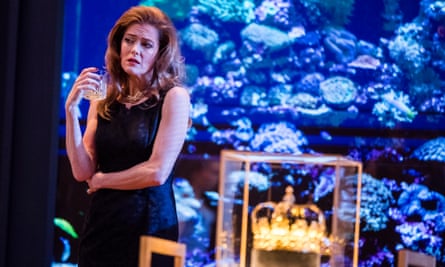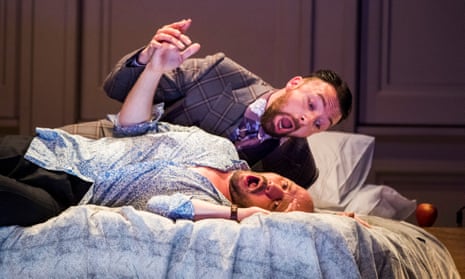George Benjamin’s first fully fledged opera, Written on Skin, has been performed widely since its premiere at the Aix-en-Provence festival six years ago and it is no surprise that his second has been co-commissioned by seven opera companies, in western Europe and the US. This time the Royal Opera gets the privilege of unveiling it; for Lessons in Love and Violence, Benjamin has again worked with the librettist Martin Crimp, and entrusted the production to director Katie Mitchell and designer Vicki Mortimer.
As in Written on Skin (and in the music-theatre piece Into the Little Hill before it) Benjamin and Crimp have used a medieval source for this unremittingly bleak demonstration of the corrosive consequences of love and obsession. This time, though, the source is a historical one. Lessons in Love and Violence is based upon the life of Edward II and his passion for his courtier Piers Gaveston, which led to him losing the throne – and to his murder soon afterwards.
Though scholars are divided over whether Edward’s relationship with Gaveston was a sexual one or whether it was his failings as a monarch that led to his downfall, Benjamin and Crimp’s retelling is unambiguous: it is the king’s infatuation with Gaveston, and his extravagance in entertaining him while many of his subjects starve, that leads to his and his lover’s destruction. It’s the king’s children, a son (the future Edward III) and a daughter, who learn the brutal lessons of the opera’s title all too well, as the ending – Crimp’s, not history’s – horrifyingly shows.
In the libretto Edward is known simply as the King; his wife Isabella becomes Isabel, Gaveston retains his name and Mortimer is the military advisor who precipitates the crisis in the monarch’s private and public lives. The text is spare, its language more or less timeless, and fits easily into the 21st-century setting of Mitchell’s beautifully detailed production. The set is an elegant bedroom, viewed from different sides in each scene; on one wall is a Francis Bacon-like portrait, and on another a fully stocked and beautifully lit marine aquarium, which is seen emptied and devoid of all life in the opera’s second half.

There’s a pervading air of menace, but the drama’s implicit violence only becomes explicit in some of the orchestral interludes. If Benjamin’s score is not quite as luminous and beguiling as his orchestral writing in Written in Skin, there are still some remarkable colours and effects – soaring horn lines, long, self-renewing melodic strands, pungent punctuations from cimbalom and wooden percussion. That is matched in some of Benjamin’s vocal writing, especially Isabel’s spiralling melismas , tailor-made for Barbara Hannigan’s extraordinary agility, and the lustrous honeyed lines in the final scenes for the the high-tenor role of the Son (who becomes Edward III), beautifully delivered by Samuel Boden.
But the writing for the other male protagonists – Stéphane Degout as the increasingly bereft King, Peter Hoare the incipiently fascist Mortimer and Gyula Orendt the suave chancer Gaveston – is far less arresting, functional rather than lyrical. And despite the care that has so clearly gone into every aspect of the production, it often seems to be the orchestral music that is really in charge of the drama, as if the usual priorities of opera have been reversed. In the end the terrible story becomes the excuse for some striking music rather than being driven along by it.
- At the Royal Opera House, London, until 26 May. Box office: 020-7304 4000.
- This piece has been edited to correct an error. The role of the Son is a high-tenor part, not a countertenor, as originally written.

Comments (…)
Sign in or create your Guardian account to join the discussion